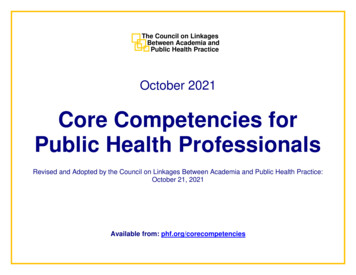
Transcription
The Council on LinkagesBetween Academia andPublic Health PracticeOctober 2021Core Competencies forPublic Health ProfessionalsRevised and Adopted by the Council on Linkages Between Academia and Public Health Practice:October 21, 2021Available from: phf.org/corecompetencies
Council on Linkages Between Academia and Public Health PracticeThe Council on Linkages Between Academia and Public Health Practice (Council on Linkages) is a collaborative of 24 nationalorganizations that aims to improve public health education and training, practice, and research. Established in 1992 to implement therecommendations of the Public Health Faculty/Agency Forum regarding increasing the relevance of public health education to thepractice of public health, the Council on Linkages works to further academic/practice collaboration to ensure a well-trained,competent workforce and the development and use of a strong evidence base for public health practice.MissionThe Council on Linkages strives to improve the performance of individuals and organizations within public health by fostering,coordinating, and monitoring collaboration among the academic, public health practice, and healthcare communities; promotingpublic health education and training for health professionals throughout their careers; and developing and advancing innovativestrategies to build and strengthen public health infrastructure.MembershipTwenty-four national organizations are members of the Council on Linkages: American Association of Colleges of Nursing Council of State and Territorial Epidemiologists American College of Preventive Medicine Council on Education for Public Health American Public Health Association Health Resources and Services Administration Association for Prevention Teaching and Research National Association of County and City Health Officials Association of Accredited Public Health Programs National Association of Local Boards of Health Association of Public Health Laboratories National Board of Public Health Examiners Association of Schools and Programs of Public Health National Environmental Health Association Association of State and Territorial Health Officials National Library of Medicine Association of University Programs in Health National Network of Public Health InstitutesAdministration Public Health Accreditation Board Centers for Disease Control and Prevention Society for Public Health Education Community-Campus Partnerships for Health Veterans Health Administration Council of Public Health Nursing OrganizationsStaff support is provided by the Public Health Foundation.For More InformationAdditional information about the Council on Linkages can be found at phf.org/councilonlinkages. Questions or requests forinformation may be sent to councilonlinkages@phf.org.The Council on LinkagesBetween Academia andPublic Health Practice1Core Competencies for Public Health ProfessionalsRevisions Adopted: October 2021
Core Competencies for Public Health ProfessionalsThe Core Competencies for Public Health Professionals (Core Competencies) are a consensus set of knowledge and skills for thebroad practice of public health, as defined by the 10 Essential Public Health Services. Developed by the Council on LinkagesBetween Academia and Public Health Practice (Council on Linkages), the Core Competencies reflect foundational or crosscuttingknowledge and skills for professionals engaging in the practice, education, and research of public health. These competenciesprovide a framework for workforce development planning and action. Organizations are encouraged to interpret and adapt the CoreCompetencies in ways that meet their specific organizational needs.The Core Competencies support workforce development within public health and can serve as a starting point for public healthprofessionals and organizations working to better understand and meet workforce development needs, improve performance,prepare for accreditation, and enhance the health of the communities they serve. The Core Competencies can be used in assessingworkforce knowledge and skills, identifying training needs, developing workforce development and training plans, crafting jobdescriptions, and conducting performance evaluations. The Core Competencies have been integrated into curricula for educationand training, provide a reference for developing public health courses, and serve as a base for sets of discipline-specificcompetencies.Development of the Core CompetenciesThe Core Competencies grew from a desire to help strengthen the public health workforce by identifying basic skills for the effectivedelivery of public health services. Building on the Universal Competencies developed by the Public Health Faculty/Agency Forum in1991, the current Core Competencies are the result of three decades of work by the Council on Linkages and other academic andpractice organizations dedicated to public health.Transitioning from a general set of Universal Competencies to a more specific set of Core Competencies began in 1998, and the firstversion of the Core Competencies was adopted by the Council on Linkages in 2001. The Council on Linkages committed to revisitingthe Core Competencies every three years to determine if revisions were needed to ensure the continued relevance of thecompetency set. The Core Competencies were revised in 2007-2010, 2013-2014, and 2020-2021.The most recent review and revision of the Core Competencies began in October 2020, resulting in significant updates to thecontent, wording, and structure of the Core Competencies. This revision process was guided by the Core Competencies Workgroupand input from the public health and population health community, and culminated in the adoption by the Council on Linkages of thecurrent set of Core Competencies in October 2021.The Council on LinkagesBetween Academia andPublic Health Practice2Core Competencies for Public Health ProfessionalsRevisions Adopted: October 2021
Key DatesSince development began in 1998, the Core Competencies have gone through four versions: 2001 version – Adopted April 11, 2001 (original version) 2010 version – Adopted May 3, 2010 2014 version – Adopted June 26, 2014 2021 version – Adopted October 21, 2021 (current version)Currently, the Core Competencies are on a three-year review cycle and are anticipated to next be considered for revision in 2024.Organization of the Core CompetenciesThe Core Competencies contain 56 competency statements that apply across the public health workforce for those engaged in thepractice, education, and research of public health. These competency statements are organized into eight domains representing skillareas within public health. In addition, the Core Competencies include three tiers, which describe different types of responsibilitieswithin public health organizations. The tiers are used to organize subcompetencies, which articulate more detailed knowledge andskills for individuals with responsibilities related to each tier.Domains Data Analytics and Assessment Skills Policy Development and Program Planning Skills Communication Skills Health Equity Skills Community Partnership Skills Public Health Sciences Skills Management and Finance Skills Leadership and Systems Thinking SkillsTiers Tier 1: Front Line and Program Support Responsibilities. These may include responsibilities such as collecting and analyzingdata, conducting restaurant inspections, assessing environmental hazards, providing health education, building communityrelationships, providing customer service, delivering services, coordinating meetings, organizing records, supportingprograms, and providing technical expertise. Tier 2: Program Management and Supervisory Responsibilities. These may include responsibilities such as developing,implementing, evaluating, and improving programs; supervising and mentoring staff; establishing and maintaining communitypartnerships; recruiting a diverse workforce; managing timelines, work plans, and budgets; advocating for program resources;making policy recommendations; and providing subject matter expertise.The Council on LinkagesBetween Academia andPublic Health Practice3Core Competencies for Public Health ProfessionalsRevisions Adopted: October 2021
Tier 3: Senior Management and Executive Leadership Responsibilities. These may include responsibilities such asoverseeing major programs or operations of the organization, setting a strategy and vision for the organization, building anequitable and inclusive organization, creating a culture of quality within the organization, collaborating with policymakers andpoliticians, advocating for organizational resources, partnering with community leadership, and leading organizational effortsto achieve health equity and social and environmental justice.Competency Statements and SubcompetenciesThis document contains two views of the Core Competencies: Competency Statements (begins on page 5) – 56 competency statements that apply across the public health workforce Competency Statements with Tiers, Subcompetencies, and Examples (begins on page 9) – more detailed knowledge andskills for individuals with responsibilities related to each tierCore Competencies Resources and ToolsA variety of resources and tools are available to assist public health professionals and organizations with using the CoreCompetencies. These include crosswalks of different versions of the Core Competencies and other workforce developmentresources, competency assessments, competency-based job descriptions, quality improvement tools, and workforce developmentplans. Core Competencies resources and tools can be found online at phf.org/corecompetenciestools. Examples of howorganizations have used the Core Competencies are available at phf.org/corecompetenciesexamples.Feedback on the Core CompetenciesThe Council on Linkages thanks the public health and population health community for its tremendous contributions to the CoreCompetencies and welcomes feedback about the Core Competencies. Examples illustrating how public health professionals andorganizations are using the Core Competencies and tools that facilitate Core Competencies use are also appreciated. Feedback,suggestions, and resources can be shared by emailing competencies@phf.org.For More InformationAdditional information about the Core Competencies, including background on development and revisions, resources and tools tofacilitate use, and current activities and events, can be found at phf.org/aboutcorecompetencies. Questions or requests forinformation may be sent to competencies@phf.org.The Council on LinkagesBetween Academia andPublic Health Practice4Core Competencies for Public Health ProfessionalsRevisions Adopted: October 2021
Core Competencies for Public Health Professionals – Competency StatementsThese competency statements apply across the public health workforce and across work settings. Whether the work setting is apublic health agency, academic institution, community-based organization, health system, or other setting, these competencies applyto professionals who practice, teach, and research public health. Specific knowledge and skills related to these competencystatements differ based on the responsibilities of an individual within an organization. These specifics are presented assubcompetencies starting on page 9.Domain 1: Data Analytics and Assessment Skills1.1.Describes factors that affect the health of a community1.2.Accesses existing quantitative and qualitative data1.3.Collects quantitative and qualitative data1.4.Analyzes quantitative and qualitative data1.5.Manages quantitative and qualitative data1.6.Uses quantitative and qualitative data1.7.Applies public health informatics in using data, information, and knowledge1.8.Assesses community health statusDomain 2: Policy Development and Program Planning Skills2.1.Develops policies, programs, and services2.2.Implements policies, programs, and services2.3.Evaluates policies, programs, services, and organizational performance2.4.Improves policies, programs, services, and organizational performanceThe Council on LinkagesBetween Academia andPublic Health Practice5Core Competencies for Public Health ProfessionalsRevisions Adopted: October 2021
2.5.Influences policies, programs, and services external to the organization2.6.Engages in organizational strategic planning2.7.Engages in community health improvement planningDomain 3: Communication Skills3.1.Determines communication strategies3.2.Communicates with internal and external audiences3.3.Responds to information, misinformation, and disinformation3.4.Facilitates communication among individuals, groups, and organizationsDomain 4: Health Equity Skills4.1.Applies principles of ethics, diversity, equity, inclusion, and justice4.2.Engages in continuous self-reflection about one’s biases4.3.Recognizes the diversity of individuals and populations4.4.Reduces systemic and structural barriers that perpetuate health inequities4.5.Implements organizational policies, programs, and services to achieve health equity and social and environmental justice4.6.Contributes to achieving and sustaining a diverse, inclusive, and competent public health workforce4.7.Advocates for health equity and social and environmental justiceDomain 5: Community Partnership Skills5.1.Describes conditions, systems, and policies affecting community health and resilience5.2.Establishes relationships to improve community health and resilienceThe Council on LinkagesBetween Academia andPublic Health Practice6Core Competencies for Public Health ProfessionalsRevisions Adopted: October 2021
5.3.Maintains relationships that improve community health and resilience5.4.Collaborates with community members and organizations5.5.Shares power and ownership with community members and othersDomain 6: Public Health Sciences Skills6.1.Describes systems, policies, and events impacting public health6.2.Applies public health sciences in delivering the 10 Essential Public Health Services6.3.Uses evidence in developing, implementing, evaluating, and improving policies, programs, and services6.4.Contributes to the evidence base for improving healthDomain 7: Management and Finance Skills7.1.Describes factors that affect the health of an organization7.2.Secures human resources7.3.Manages human resources7.4.Engages in professional development7.5.Secures financial resources7.6.Manages financial resources7.7.Implements organizational policies, programs, and services to achieve diversity, equity, inclusion, and justice7.8.Manages programs and services7.9.Engages in contingency planning7.10. Applies critical thinking in decision makingThe Council on LinkagesBetween Academia andPublic Health Practice7Core Competencies for Public Health ProfessionalsRevisions Adopted: October 2021
7.11. Engages individuals and teams to achieve program and organizational goals7.12. Facilitates collaboration among individuals, groups, and organizations7.13. Engages in performance managementDomain 8: Leadership and Systems Thinking Skills8.1.Creates opportunities to achieve cross-sector alignment8.2.Implements a vision for a healthy community8.3.Addresses facilitators and barriers impacting delivery of the 10 Essential Public Health Services8.4.Creates opportunities for creativity and innovation8.5.Responds to emerging needs8.6.Manages organizational change8.7.Engages politicians, policymakers, and the public to support public health infrastructure8.8.Advocates for public healthThe Council on LinkagesBetween Academia andPublic Health Practice8Core Competencies for Public Health ProfessionalsRevisions Adopted: October 2021
Core Competencies for Public Health Professionals – Competency Statements with Tiers, Subcompetencies, andExamplesThe Core Competencies include three tiers, which describe different types of responsibilities within public health organizations.Individuals working in public health often have responsibilities that cut across tiers. These tiers are used to organizesubcompetencies, which articulate more detailed knowledge and skills for individuals with responsibilities related to each tier.TiersTier 1: Front Line and Program Support Responsibilities. These may include responsibilities such as collecting and analyzing data,conducting restaurant inspections, assessing environmental hazards, providing health education, building community relationships,providing customer service, delivering services, coordinating meetings, organizing records, supporting programs, and providingtechnical expertise.Tier 2: Program Management and Supervisory Responsibilities. These may include responsibilities such as developing,implementing, evaluating, and improving programs; supervising and mentoring staff; establishing and maintaining communitypartnerships; recruiting a diverse workforce; managing timelines, work plans, and budgets; advocating for program resources;making policy recommendations; and providing subject matter expertise.Tier 3: Senior Management and Executive Leadership Responsibilities. These may include responsibilities such as overseeing majorprograms or operations of the organization, setting a strategy and vision for the organization, building an equitable and inclusiveorganization, creating a culture of quality within the organization, collaborating with policymakers and politicians, advocating fororganizational resources, partnering with community leadership, and leading organizational efforts to achieve health equity and socialand environmental justice.The Council on LinkagesBetween Academia andPublic Health Practice9Core Competencies for Public Health ProfessionalsRevisions Adopted: October 2021
Domain 1: Data Analytics and Assessment Skills1.1.Describes factors that affect the health of a community (e.g., income, education, laws, environment, climate change, resilience,homelessness, food security, access to healthcare, racial equity, distribution of resources and power, social and communityengagement, changing demographics)Tier 1 Subcompetencies:Tier 2 Subcompetencies:Tier 3 Subcompetencies:T1: 1.1.1. Identifies factors affecting thehealth of a communityT2: 1.1.1. Identifies factors affecting thehealth of a communityT3: 1.1.1. Identifies factors affecting thehealth of a communityT1: 1.1.2. Describes factors affecting thehealth of a communityT2: 1.1.2. Describes factors affecting thehealth of a communityT3: 1.1.2. Describes factors affecting thehealth of a community1.2.Accesses existing quantitative and qualitative data (e.g., community input, big data, vital statistics, electronic health records,transportation patterns, employment statistics, environmental monitoring, health equity impact assessments, revenue andexpenditures)Tier 1 Subcompetencies:Tier 2 Subcompetencies:Tier 3 Subcompetencies:T1: 1.2.1. Identifies data needs (e.g., subcounty, real-time, trends, race andethnicity, social determinants ofhealth, surrounding jurisdictions,comparable jurisdictions forcomparative purposes)T2: 1.2.1. Determines data needs (e.g., subcounty, real-time, trends, race andethnicity, social determinants ofhealth, surrounding jurisdictions,comparable jurisdictions forcomparative purposes)T3: 1.2.1. Determines data needs (e.g., subcounty, real-time, trends, race andethnicity, social determinants ofhealth, surrounding jurisdictions,comparable jurisdictions forcomparative purposes)T1: 1.2.2. Identifies sources of existing data(e.g., what is available, what isaccessible, how to access)T2: 1.2.2. Determines sources of existingdata (e.g., what is available, whatis accessible, how to access)T3: 1.2.2. Determines sources of existingdata (e.g., what is available, whatis accessible, how to access)T1: 1.2.3. Analyzes the quality of existingdata (e.g., accuracy, bias,completeness, validity, reliability,integrity, credibility, source,relevance, timeliness, applicability,generalizability)T2: 1.2.3. Analyzes the quality of existingdata (e.g., accuracy, bias,completeness, validity, reliability,integrity, credibility, source,relevance, timeliness, applicability,generalizability)T3: 1.2.3. Evaluates the quality of existingdata (e.g., accuracy, bias,completeness, validity, reliability,integrity, credibility, source,relevance, timeliness, applicability,generalizability)The Council on LinkagesBetween Academia andPublic Health Practice10Core Competencies for Public Health ProfessionalsRevisions Adopted: October 2021
T1: 1.2.4. Analyzes the comparability ofexisting data (e.g., data being ageadjusted to the same year, datavariables across datasets havingsimilar definitions, trends overtime, differences in data collectioninstruments)T2: 1.2.4. Analyzes the comparability ofexisting data (e.g., data being ageadjusted to the same year, datavariables across datasets havingsimilar definitions, trends overtime, differences in data collectioninstruments)T3: 1.2.4. Evaluates the comparability ofexisting data (e.g., data being ageadjusted to the same year, datavariables across datasets havingsimilar definitions, trends overtime, differences in data collectioninstruments)T1: 1.2.5. Selects existing dataT2: 1.2.5. Selects existing dataT3: 1.2.5. Selects existing dataT3: 1.2.6. Facilitates access to existing dataT1: 1.2.6. Identifies gaps in existing data1.3.T2: 1.2.6. Identifies gaps in existing dataT3: 1.2.7. Identifies gaps in existing dataCollects quantitative and qualitative dataTier 1 Subcompetencies:Tier 2 Subcompetencies:Tier 3 Subcompetencies:T1: 1.3.1. Explains the importance of datacollection for designing,implementing, evaluating, andimproving policies, programs, andservicesT2: 1.3.1. Explains the importance of datacollection for designing,implementing, evaluating, andimproving policies, programs, andservicesT3: 1.3.1. Explains the importance of datacollection for designing,implementing, evaluating, andimproving policies, programs, andservicesT1: 1.3.2. Selects methods and tools forcollecting dataT2: 1.3.2. Selects methods and tools forcollecting dataT3: 1.3.2. Selects methods and tools forcollecting dataThe Council on LinkagesBetween Academia andPublic Health Practice11Core Competencies for Public Health ProfessionalsRevisions Adopted: October 2021
T1: 1.3.3. Uses methods and tools forcollecting data (e.g., usinginformation technology, applyinguser experience principles,ensuring data integrity, leveragingnational data standards andexisting data systems, applyingcontrol techniques when handlingdata, providing real-timesurveillance data, ensuringsufficient granularity to not hidedisparities)T2: 1.3.3. Uses methods and tools forcollecting data (e.g., usinginformation technology, applyinguser experience principles,ensuring data integrity, leveragingnational data standards andexisting data systems, applyingcontrol techniques when handlingdata, providing real-timesurveillance data, ensuringsufficient granularity to not hidedisparities)T3: 1.3.3. Uses methods and tools forcollecting data (e.g., usinginformation technology, applyinguser experience principles,ensuring data integrity, leveragingnational data standards andexisting data systems, applyingcontrol techniques when handlingdata, providing real-timesurveillance data, ensuringsufficient granularity to not hidedisparities)T3: 1.3.4. Ensures collection of data (e.g.,ensuring data are valid, reliable,representative of community,equitable)1.4.Analyzes quantitative and qualitative dataTier 1 Subcompetencies:Tier 2 Subcompetencies:Tier 3 Subcompetencies:T1: 1.4.1. Explains the importance of dataanalysis for designing,implementing, evaluating, andimproving policies, programs, andservicesT2: 1.4.1. Explains the importance of dataanalysis for designing,implementing, evaluating, andimproving policies, programs, andservicesT3: 1.4.1. Explains the importance of dataanalysis for designing,implementing, evaluating, andimproving policies, programs, andservicesT1: 1.4.2. Prepares data for analysis (e.g.,coding data, cleaning data,structuring data, determining thequality of data, determining thecomparability of data, deidentifying data)T2: 1.4.2. Prepares data for analysis (e.g.,coding data, cleaning data,structuring data, determining thequality of data, determining thecomparability of data, deidentifying data)T3: 1.4.2. Prepares data for analysis (e.g.,organizing financial data,determining the quality of data,determining the comparability ofdata, de-identifying data)T1: 1.4.3. Selects methods and tools foranalyzing dataT2: 1.4.3. Selects methods and tools foranalyzing dataT3: 1.4.3. Selects methods and tools foranalyzing dataThe Council on LinkagesBetween Academia andPublic Health Practice12Core Competencies for Public Health ProfessionalsRevisions Adopted: October 2021
T1: 1.4.4. Uses methods and tools foranalyzing data (e.g., usinginformation technology, statisticalsoftware, Excel, qualitative dataanalysis software, GIS, spatialanalysis; ensuring data integrity;applying control techniques whenhandling data; disaggregating datato not hide disparities)T2: 1.4.4. Uses methods and tools foranalyzing data (e.g., usinginformation technology, statisticalsoftware, Excel, qualitative dataanalysis software, GIS, spatialanalysis; ensuring data integrity;applying control techniques whenhandling data; disaggregating datato not hide disparities)T3: 1.4.4. Uses methods and tools foranalyzing data (e.g., usinginformation technology, statisticalsoftware, Excel, qualitative dataanalysis software, GIS, spatialanalysis; ensuring data integrity;applying control techniques whenhandling data; disaggregating datato not hide disparities)T3: 1.4.5. Ensures analysis of data1.5.Manages quantitative and qualitative dataTier 1 Subcompetencies:Tier 2 Subcompetencies:Tier 3 Subcompetencies:T1: 1.5.1. Explains the importance of datamanagement for designing,implementing, evaluating, andimproving policies, programs, andservicesT2: 1.5.1. Explains the importance of datamanagement for designing,implementing, evaluating, andimproving policies, programs, andservicesT3: 1.5.1. Explains the importance of datamanagement for designing,implementing, evaluating, andimproving policies, programs, andservicesT1: 1.5.2. Contributes to development ofdata management plansT2: 1.5.2. Develops data management plansT3: 1.5.2. Ensures development of datamanagement plansT1: 1.5.3. Implements data managementplansT2: 1.5.3. Implements data managementplansT3: 1.5.3. Ensures implementation of datamanagement plansT1: 1.5.4. Ensures protection of data (e.g.,knowing what data areconfidential, knowing whatconfidentiality entails,safeguarding confidential data,ensuring data integrity)T2: 1.5.4. Ensures protection of data (e.g.,knowing what data areconfidential, knowing whatconfidentiality entails,safeguarding confidential data,ensuring data integrity)T3: 1.5.4. Ensures protection of data (e.g.,knowing what data areconfidential, knowing whatconfidentiality entails,safeguarding confidential data,ensuring data integrity, identifyingand implementing training andpolicies)The Council on LinkagesBetween Academia andPublic Health Practice13Core Competencies for Public Health ProfessionalsRevisions Adopted: October 2021
T1: 1.5.5. Ensures public availability of data(e.g., practicing FAIR principles,de-identifying data, implementingopen data standards)1.6.T2: 1.5.5. Ensures public availability of data(e.g., practicing FAIR principles,de-identifying data, implementingopen data standards)T3: 1.5.5. Ensures public availability of data(e.g., practicing FAIR principles,de-identifying data, implementingopen data standards)Uses quantitative and qualitative dataTier 1 Subcompetencies:Tier 2 Subcompetencies:Tier 3 Subcompetencies:T1: 1.6.1. Describes public healthapplications of dataT2: 1.6.1. Describes public healthapplications of dataT3: 1.6.1. Describes public healthapplications of dataT1: 1.6.2. Considers limitations of data (e.g.,accuracy, bias, completeness,validity, reliability, integrity,credibility, source, relevance,timeliness, applicability,generalizability)T2: 1.6.2. Considers limitations of data (e.g.,accuracy, bias, completeness,validity, reliability, integrity,credibility, source, relevance,timeliness, applicability,generalizability)T3: 1.6.2. Considers limitations of data (e.g.,accuracy, bias, completeness,validity, reliability, integrity,credibility, source, relevance,timeliness, applicability,generalizability)T1: 1.6.3. Recognizes the context in whichdata were collectedT2: 1.6.3. Recognizes the context in whichdata were collectedT3: 1.6.3. Recognizes the context in whichdata were collectedT1: 1.6.4. Interprets dataT2: 1.6.4. Interprets dataT3: 1.6.4. Interprets dataT1: 1.6.5. Uses data to determine the rootcauses of health disparities andinequitiesT2: 1.6.5. Uses data to determine the rootcauses of health disparities andinequitiesT3: 1.6.5. Uses data to determine the rootcauses of health disparities andinequitiesT1: 1.6.6. Uses data to inform plans andoperations (e.g., strategic plan,quality improvement plan,professional development)T2: 1.6.6. Uses data to inform plans andoperations (e.g., strategic plan,quality improvement plan,professional development)T3: 1.6.6. Uses data to inform plans andoperations (e.g., strategic plan,quality improvement plan,professional development)The Council on LinkagesBetween Academia andPublic Health Practice14Core Competencies for Public Health ProfessionalsRevisions Adopted: October 2021
1.7.Applies public health informatics in using data, information, and knowledgeTier 1 Subcompetencies:Tier 2 Subcompetencies:Tier 3 Subcompetencies:T1: 1.7.1. Explains the importance of publichealth informatics for designing,implementing, evaluating, andimproving policies, programs, andservicesT2: 1.7.1. Explains the importance of publichealth informatics for designing,implementing, evaluating, andimproving policies, programs, andservicesT3: 1.7.1. Explains the importance of publichealth informatics for designing,implementing, evaluating, andimpro
5 Core Competencies for Public Health Professionals Revisions Adopted: October 2021 The Council on Linkages Between Academia and Public Health Practice Core Competencies for Public Health Professionals – Competency Statements These competency statements apply acr
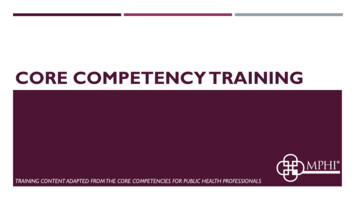
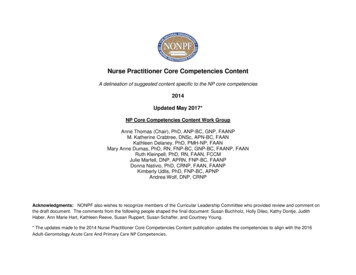



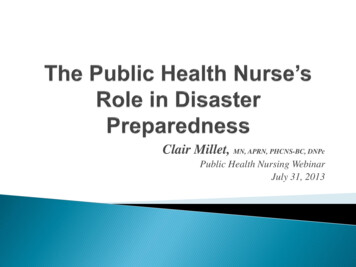

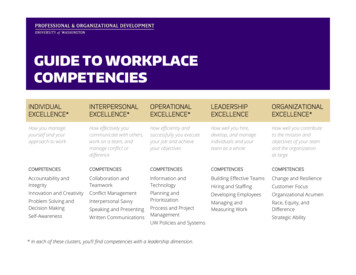
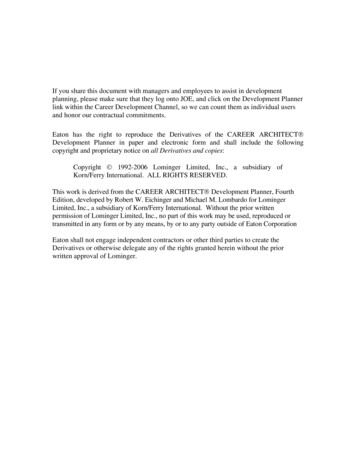
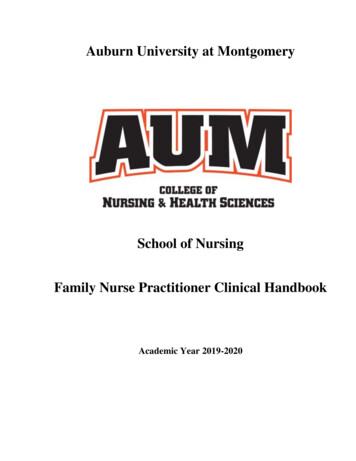
![03[1] Analysis of the Internal Environment](/img/2/031-analysis-of-the-internal-environment.jpg)